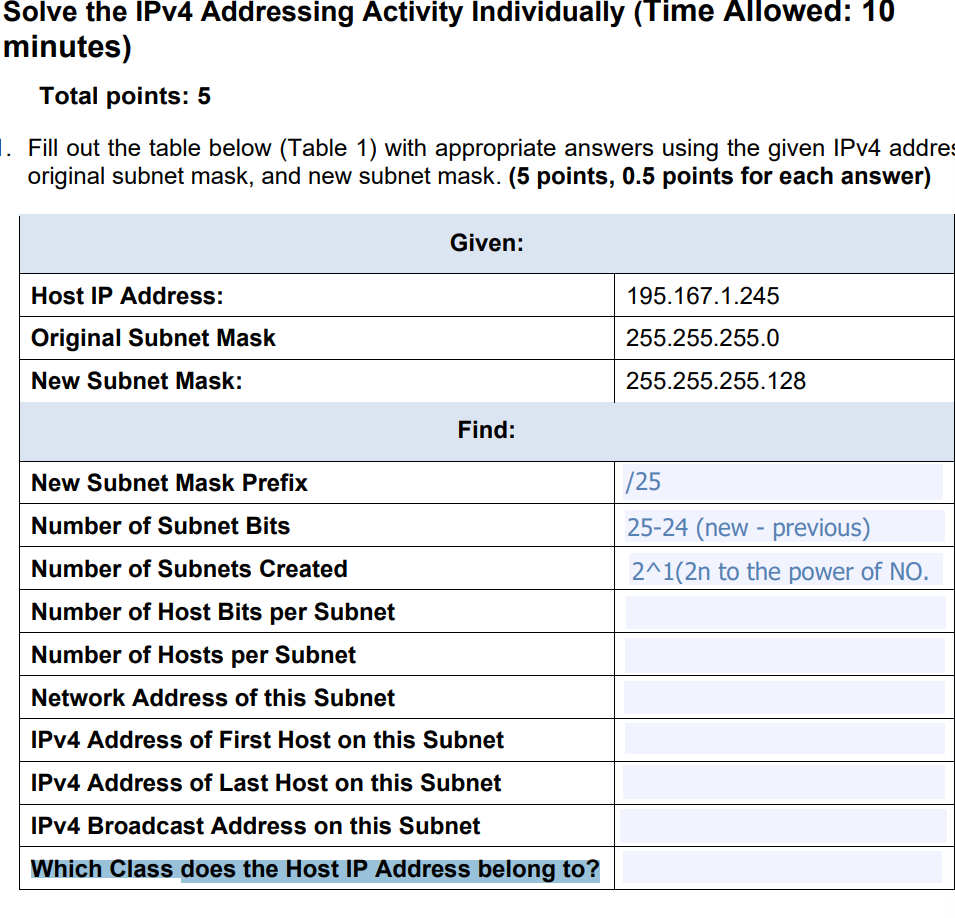What class does the Host IP Address belong to?

Understand the Problem
The question is asking to fill out a table using an IPv4 address, the original and new subnet masks, and to find various related details such as the subnet mask prefix, number of subnets, and class of the host IP address.
Answer
New Subnet Mask Prefix: /25; Number of Subnet Bits: 1; Number of Subnets Created: 2; Number of Host Bits per Subnet: 7; Number of Hosts per Subnet: 126; Network Address: 195.167.1.128; IPv4 Address of First Host: 195.167.1.129; IPv4 Address of Last Host: 195.167.1.254; IPv4 Broadcast Address: 195.167.1.255; Class of Host IP Address: Class C.
Answer for screen readers
- New Subnet Mask Prefix: /25
- Number of Subnet Bits: 1
- Number of Subnets Created: 2
- Number of Host Bits per Subnet: 7
- Number of Hosts per Subnet: 126
- Network Address: 195.167.1.128
- IPv4 Address of First Host: 195.167.1.129
- IPv4 Address of Last Host: 195.167.1.254
- IPv4 Broadcast Address: 195.167.1.255
- Class of Host IP Address: Class C
Steps to Solve
- Identify the New Subnet Mask Prefix
To find the subnet mask prefix for the new subnet mask $255.255.255.128$, we convert it to binary:
$$
255.255.255.128 = 11111111.11111111.11111111.10000000
$$
The prefix length is 25 because there are 25 ones in the binary representation.
- Calculate Number of Subnet Bits
The number of subnet bits is calculated as the difference between the new prefix and the original prefix. The original subnet mask of $255.255.255.0$ corresponds to /24.
Number of subnet bits = $25 - 24 = 1$
- Determine Number of Subnets Created
The number of subnets created can be calculated using the formula:
$$
\text{Number of Subnets} = 2^{\text{Number of Subnet Bits}}
$$
Substituting the value:
$$
\text{Number of Subnets} = 2^1 = 2
$$
- Calculate Number of Host Bits per Subnet
The number of host bits per subnet is calculated by subtracting the subnet bits from 32 (the total number of bits in an IPv4 address):
$$
\text{Number of Host Bits} = 32 - 25 = 7
$$
- Calculate Number of Hosts per Subnet
The number of hosts per subnet can be found using the formula:
$$
\text{Number of Hosts} = 2^{\text{Number of Host Bits}} - 2
$$
(We subtract 2 for the network and broadcast addresses.)
$$
\text{Number of Hosts} = 2^{7} - 2 = 128 - 2 = 126
$$
- Determine the Network Address of this Subnet
The network address is found by performing a bitwise AND operation between the IP address and the subnet mask:
$$
195.167.1.245 \land 255.255.255.128 = 195.167.1.128
$$
- Identify the IPv4 Address of the First Host in this Subnet
The first usable host address is one more than the network address:
$$
\text{First Host} = 195.167.1.128 + 1 = 195.167.1.129
$$
- Identify the IPv4 Address of the Last Host in this Subnet
The last usable host address is two less than the broadcast address. First, we find the broadcast address, next step.
- Determine the IPv4 Broadcast Address of this Subnet
The broadcast address is the highest address in the subnet:
$$
\text{Broadcast Address} = 195.167.1.255
$$
- Identify the IPv4 Address of the Last Host in this Subnet
The last usable host address is one less than the broadcast address:
$$
\text{Last Host} = 195.167.1.255 - 1 = 195.167.1.254
$$
- Determine Which Class the Host IP Address Belongs To
Classes of IP addresses can be identified as follows:
- Class A: $1.0.0.0$ to $126.255.255.255$
- Class B: $128.0.0.0$ to $191.255.255.255$
- Class C: $192.0.0.0$ to $223.255.255.255$
Since $195.167.1.245$ falls in the range of Class C, it belongs to Class C.
- New Subnet Mask Prefix: /25
- Number of Subnet Bits: 1
- Number of Subnets Created: 2
- Number of Host Bits per Subnet: 7
- Number of Hosts per Subnet: 126
- Network Address: 195.167.1.128
- IPv4 Address of First Host: 195.167.1.129
- IPv4 Address of Last Host: 195.167.1.254
- IPv4 Broadcast Address: 195.167.1.255
- Class of Host IP Address: Class C
More Information
This problem illustrates the concepts of subnetting in IPv4, where understanding how to derive subnets and calculate associated addresses is crucial for network management. Subnetting helps in efficient IP address management and reduces network congestion.
Tips
- Forgetting to subtract 2 when calculating usable hosts. It's important to account for the network and broadcast addresses.
- Miscalculating subnet bits and host bits by confusing prefix lengths.
- Incorrectly identifying IP classes based on the first octet value.
AI-generated content may contain errors. Please verify critical information